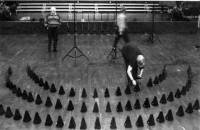Accéder à la page Mathématiques et Musiques du Monde Arabe
Perception du temps
Vendredi 9 mai 2014
14h30
IRCAM - Salle Stravinsky
1, place Igor Stravinsky 75004 Paris
Entrée libre
Avec la participation de John Wearden (Keele University), Mark Gotham (University of Cambridge), Virginie Van Wassenhove (INSERM).
Programme
- 14h30-15h15 : John Wearden - Contemporary research in the perception of time
- 15h15-16h00 : Virginie van Wassenhove - Temporal event structuring and the brain's chronoarchitecture
- 16h00-16h45 : Mark Gotham - Mathematical Models for Metric Theory
Résumé des interventions
Contemporary research in the perception of time
John Wearden
This talk is intended to give an overview of some issues in contemporary research in time perception. I first discuss a little of the history of time perception, then move on to internal clock ideas initially developed in the 1960s. Clock models are best applied to “prospective timing” situations, those where the experimental participant is informed that time is an important dimension of the experiment. Some examples of data from my own research, including illustrations of the “scalar property” of time and “speeding up the clock” effects, will be presented. Another important area is “retrospective timing”, time judgements made when people are asked unexpected questions about time. Retrospective timing is usually thought to be linked to more general cognitive processing, and some examples will be given of situations in which this idea seems to work, and others in which it doesn’t. Finally, I will discuss “passage of time judgements”, judgements of how fast time seems to be passing during some event, with research from both the laboratory and everyday life, including a recent study of passage of time in the daily lives of students and a comparison group 50 years older.
[Voir la vidéo]
[Fermer]
Temporal event structuring and the brain's chronoarchitecture
Virginie van Wassenhove
One goal of time research is to link the dynamics of brain processes (timing) with the conscious experience of time (time perception). Two approaches can be taken.
First, and traditionally, the hallmark of time perception is the experience of duration or “time quantity” (Lambrechts et al, 2013) necessitating two temporal markers that are the onset and the offset of an event. Brain responses to temporal markers can be indexed evoked brain activity although this presupposes a latency-code mechanism for the temporal event encoding, which may be difficult to reconcile with the inherent temporal delays of cortical information processing (van Wassenhove, 2009).
For instance, the temporal coincidence of auditory (A) and visual (V) events is a necessary condition for multisensory integration, yet coincidence is defined by the brain, not by veridical simultaneity. Consistent with this, the perception of audiovisual (AV) speech tolerates as much as 250 ms of desynchrony between sensory inputs suggesting the existence of temporal encoding windows (van Wassenhove et al, 2007) or temporal constants (Kösem & van Wassenhove, 2012).
A second approach consists in describing neural activity in terms of neural oscillations which naturally provide such temporal constants (Treisman et al, 1990; Pöppel, 1997, 2009; Buhusi & Meck, 2005; van Wassenhove, 2009). In this view, the dynamics of brain activity provide a logistical platform or chronoarchitecture hypothesized to serve canonical operations for temporal event structuring at all scales. If this is the case, distinct neurophysiological markers should be found that index the structuring of events in time specifically for time perception and temporal cognition.
[Voir la vidéo]
[Fermer]
Mathematical Models for Metric Theory
Mark Gotham
Many standard accounts of musical metre (such as Lerdahl and Jackendoff 1983) assign equal value to each structural level, however empirically-tested cognitive preferences (see London 2012 for a summary) suggest a more nuanced quantification by weighting them on the basis of pulse salience (Parncutt 1994). These principles are modelled well by a Gaussian distribution relating the inter onset interval of a pulse to its salience. With this improved account of the relative importance of each pulse level, an additive system combining them can at last stand as a worthy model of metre. This paper sets out that model and advances applications.
First, the criteria for selecting tempo to optimise the net salience of a metre are identified. It is shown that maximal salience interacts in simple, categorical ways with the tempo, metrical structure, and the number of metrical levels represented. This model suggests a set of ‘default’ tempi specific to various categories of metres. The division of metres into these categories is intriguingly counter-intuitive. The model also provides a more rigorous basis for the definition of what it means for music to be ‘fast’ or ‘slow’ in those contexts.
Second is a model of categorical metrical listening after Large and Palmer's 2002 waves of expectation. This paper adapts Large and Palmer’s model to include the more subtle quantification of metrical weight described above. The implications include a categorical disparity between metrical positions formerly considered equal, and the prospective development of a quantification of metrical instability.
[Voir la vidéo]
[Fermer]
